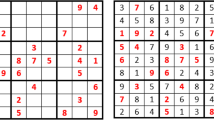Abstract
A Taguchi-based genetic algorithm (TBGA) is proposed to solve Japanese nonogram puzzles. The TBGA exploits the power of global exploration inherent in the traditional genetic algorithm (GA) and the abilities of the Taguchi method in efficiently generating offspring. In past researches, the GA with binary encoding and inappropriate fitness functions makes a huge search space size and inaccurate direction for searching the solution of a nonogram. Consequently, the GA does not easily converge to the solution. The proposed TBGA includes the effective condensed encoding, the improved fitness function, the modified crossover, the modified mutation, and the Taguchi method for solving Japanese nonograms. The systematic reasoning ability of the Taguchi method is incorporated in the modified crossover operation to select the better genes to achieve crossover, and eventually enhance the GA. In this study, the condensed encoding can make sure that the chromosome is a feasible solution in all rows for Japanese nonograms. In the reconstruction process of a Japanese nonogram, the numbers in the left column are used as encoding conditions, and the numbers in the top row with the improved fitness function are employed to evaluate the reconstruction result. From the computational experiments, the proposed TBGA approach is effectively applied to solve nonograms and better than a GA does.
Similar content being viewed by others
References
Batenburg KJ, Kosters WA (2004) A discrete tomography approach to Japanese puzzles. In: Proc Belgian–Dutch conference artificial intelligence, Groningen, The Netherlands, pp 243–250
Batenburg KJ, Kosters WA (2008) A reasoning framework for solving nonograms. In: 12th international workshop on combinatorial image analysis, vol 4958, pp 372–383
Batenburg KJ, Kosters WA (2009) Solving nonograms by combining relaxations. Pattern Recognit 42(8):1672–1683
Benton J, Snow R, Wallach N (2005) A combinatorial problem associated with nonograms. Technical Report, Artificial Intelligence Dept, Stanford Univ, Stanford, CA
Garbolino T, Papa G (2010) Genetic algorithm for test pattern generator design. Appl Intell 32:193–204
Jing MQ, Yu CH, Lee HL, Chen LH (2009) Solving Japanese puzzles with logical rules and depth first search algorithm. In: Proceedings of the 2009 international conference on machine learning and cybernetics, vol 5, pp 2962–2967
Korkmaz EE (2010) Multi-objective genetic algorithms for grouping problems. Appl Intell 33:179–192
Lee KM, Tsai JT, Liu TK, Chou JH (2010) Improved genetic algorithm for mixed-discrete-continuous design optimization problems. Eng Optim 42(10):927–941
Liu TK, Tsai JT, Chou JH (2006) Improved genetic algorithm for job-shop scheduling problem. Int J Adv Manuf Technol 27(9–10):1021–1029
Ortiz-Garcia EG, Salcedo-Sanz S, Perez-Bellido AM, Carro-Calvo L, Portilla-Figueras A, Yao X (2009) Improving the performance of evolutionary algorithms in grid-based puzzles resolution. Evol Intell 2(4):169–181
Özyer T, Zhang M, Alhajj R (2011) Integrating multi-objective genetic algorithm based clustering and data partitioning for skyline computation. Appl Intell 35:110–122
Salcedo-Sanz S, Portilla-Figueras JA, Ortiz-Garcia EG, Perez-Bellido AM, Yao X (2007) Teaching advanced features of evolutionary algorithms using Japanese puzzles. IEEE Trans Ed 50:151–156
Taguchi G, Chowdhury S, Taguchi S (2000) Robust engineering. McGraw-Hill, New York
Tsai JT (2010) Robust optimal-parameter design approach for tolerance design problems. Eng Optim 42(12):1079–1093
Tsai JT, Chou JH, Liu TK (2006a) Optimal design of digital IIR filters using hybrid Taguchi genetic algorithm. IEEE Trans Ind Electron 53(3):867–879
Tsai JT, Chou JH, Liu TK (2006b) Tuning the structure and parameters of a neural network by using hybrid Taguchi-genetic algorithm. IEEE Trans Neural Netw 17(1):69–80
Tsai JT, Chou PY, Fang JC (2011) Learning intelligent genetic algorithms using Japanese nonograms. IEEE Trans Ed. doi:10.1109/TE.2011.2158214
Tsai JT, Liu TK, Chou JH (2004) Hybrid Taguchi-genetic algorithm for global numerical optimization. IEEE Trans Evol Comput 8(4):365–377
Tsai JT, Liu TK, Ho WH, Chou JH (2008) An improved genetic algorithm for job-shop scheduling problems using Taguchi-based crossover. Int J Adv Manuf Technol 38(9–10):987–994
Tsai JT, Ho WH, Chou JH (2009) Design of two-dimensional IIR digital structure-specified filters by using an improved genetic algorithm. Expert Syst Appl 36(3):6928–6934
Ueda N, Nagao T (1996) NP-completeness results for nonograms via parsimonious reductions. Technical Report TR96-0008, Tokyo Institute of Technology, Tokyo, Japan
Wang L, Zheng DZ (2002) A modified genetic algorithm for job shop scheduling. Int J Adv Manuf Technol 20:72–76
Wiggers W (2004) A comparison of a genetic algorithm and a depth first search algorithm applied to Japanese nonograms. In: Proceedings of the first twente student conference on IT, pp 1–6
Wu Y (2000) Taguchi methods for robust design. The American Society of Mechanical Engineers, New York
Xing H, Qu R (2011) A compact genetic algorithm for the network coding based resource minimization problem. Applied Intelligence, doi:10.1007/s10489-011-0298-8
Yen SJ, Su TC, Chiu SY, Chen JC (2010) Optimization of nonogram’s solver by using an efficient algorithm. In: 2010 International conference on technologies and applications of artificial intelligence, pp 444–449
Yu B, Yang Z (2009) A dynamic holding strategy in public transit systems with real-time information. Appl Intell 31:69–80
Yu CH, Lee HL, Chen LH (2011) An efficient algorithm for solving nonograms. Appl Intell 35:18–31
Zhang R, Wu C (2010) A hybrid approach to large-scale job shop scheduling. Appl Intell 32:47–59
Author information
Authors and Affiliations
Corresponding author
Rights and permissions
About this article
Cite this article
Tsai, JT. Solving Japanese nonograms by Taguchi-based genetic algorithm. Appl Intell 37, 405–419 (2012). https://doi.org/10.1007/s10489-011-0335-7
Published:
Issue Date:
DOI: https://doi.org/10.1007/s10489-011-0335-7




